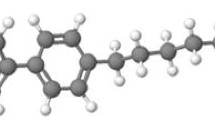Abstract
The monolayer of CdSe/CdS/ZnS quantum dots was formed on the water surface at 11, 21, and 31 °C and studied by compression isotherms. Increasing subphase temperature increases the lift-off point of the monolayer and decreases the minimum area which can be reached on compression. Compression changes the monolayer state from LE to LC. The highest compression state can be reached at the lowest subphase temperatures. Increasing water subphase temperature leads to increasing homogeneity of the monolayers. Increasing subphase temperature leads to increasing quiescent layer thickness and diffusion rate. At the high subphase temperature, a duration of collective flowing of desorption processes from water interface to quiescent layer and from quiescent layer to turbulent layer is decreasing that connected with reaching a quiescent layer with which the saturation does not take a place at the achieved diffusion rate.








Similar content being viewed by others
References
Randall, J. N., Luscombe, J. H., & Bate, R. T. (1994). Chapter 13—quantum dot devices. VLSI Electronics Microstructure Science, 24, 419–445.
Kima, H. S., & Yoon, K. B. (2014). Preparation and characterization of CdS and PbS quantum dots in zeolite Y and their applications for nonlinear optical materials and solar cell. Coordination Chemistry Reviews, 263–264, 239–256.
Lim, J., Park, M., Bae, W. K., et al. (2013). Highly efficient cadmium-free quantum dot light-emitting diodes enabled by the direct formation of excitons within InP@ZnSeS quantum dots. ACS Nano, 7(10), 9019–9026.
Chuang, P. H., Lin, C. C., & Liu, R. S. (2014). Emission-tunable CuInS2/ZnS quantum dots: structure, optical properties, and application in white light-emitting diodes with high color rendering index. ACS Applied Materials & Interfaces, 6, 15379–15387.
Liu, I. P., Chang, C. W., Teng, H., et al. (2014). Performance enhancement of quantum-dot-sensitized solar cells by potential-induced ionic layer adsorption and reaction. ACS Applied Materials & Interfaces, 6, 19378–19384.
Jin, H., Choi, S., Lee, H. J., et al. (2013). Layer-by-layer assemblies of semiconductor quantum dots for nanostructured photovoltaic devices. Journal of Physical Chemistry Letters, 4, 2461–2470.
Reed, M. A., & Seabaugh, A. C. (1994). Prospects for semiconductor quantum devices. Molecular and Biomolecular Electronics, 240(2), 15–42.
Eita, M., Wagberg, L., & Muhammed, M. (2012). Spin-assisted multilayers of poly(methyl methacrylate) and zinc oxide quantum dots for ultraviolet-blocking applications. ACS Applied Materials & Interfaces, 4, 2920–2925.
Leck, K. S., Divayana, Y., Zhao, D., et al. (2013). Quantum dot light-emitting diode with quantum dots inside the hole transporting layers. ACS Applied Materials & Interfaces, 5, 6535–6540.
Bae, W. K., Kwak, J., Lim, J., et al. (2010). Multicolored light-emitting diodes based on all-quantum-dot multilayer films using layer-by-layer assembly method. Nano Letters, 10, 2368–2373.
Lambert, K., Wittebrood, L., Moreels, I., et al. (2006). Langmuir–Blodgett monolayers of InP quantum dots with short chain ligands. Journal of Colloid and Interface Science, 300, 597–602.
Lambert, K., Capek, R. K., Bodnarchuk, M. I., et al. (2010). Langmuir-Schaefer deposition of quantum dot multilayers. Langmuir, 26(11), 7732–7736.
Protasov, D. Y., Jian, W. B., Svit, K. A., et al. (2011). Formation of arrays of free-standing CdS quantum dots using the Langmuir-Blodgett technique. Journal of Physical Chemistry C, 115, 20148–20152.
Albrecht, O., Matsuda, H., Eguchi, K., et al. (1999). The dissolution of myristic acid monolayers in water. Thin Solid Films, 338, 252–264.
Radhakrishnan, C., Lo, M. K. F., Knobler, C. M., et al. (2011). Capping-ligand effect on the stability of CdSe quantum dot Langmuir monolayers. Langmuir, 27, 2099–2103.
Shen, Y. J., Lee, Y. L., & Yang, Y. M. (2006). Monolayer behavior and Langmuir-Blodgett manipulation of CdS quantum dots. The Journal of Physical Chemistry. B, 110, 9556–9564.
Li, J. J., Wang, Y. A., Guo, W., Keay, J. C., Mishima, T. D., Johnson, M. B., & Peng, X. (2003). Large-scale synthesis of nearly monodisperse CdSe/CdS core/shell nanocrystals using air-stable reagents via successive ion layer adsorption and reaction. Journal of the American Chemical Society, 125, 12567–12575.
Speranskaya, E. S., Beloglazova, N. V., Lenain, P., De Saeger, S., Wang, Z., Zhang, S., Hens, Z., Knopp, D., Potapkin, D. V., & Goryacheva, I. Y. (2014). Polymer-coated fluorescent CdSe-based quantum dots for application in immunoassay. Biosensors and Bioelectronics, 53, 225–231.
Smith, R. D., & Berg, J. C. (1980). The collapse of surfactant monolayers at the air-water interface. Journal of Colloid and Interface Science, 74(1), 273–286.
Ter-Minassian-Saraga, L. (1956). Recent work on spread monolayers, adsorption and desorption. Journal of Colloid Science, 11, 398–418.
Adamson, A. W., & Gast, A. P. (1997). Physical chemistry of surfaces (sixth ed.). New-York: John Wiley & Sons Inc A wiley-interscience publication.
Matshaya, T. J., Lanterna, A. E., Granados, A. M., et al. (2014). Distinctive interactions of oleic acid covered magnetic nanoparticles with saturated and unsaturated phospholipids in Langmuir monolayers. Langmuir, 30, 5888–5896.
Pad, S. G., Matthews, R. H., & Cornwel, D. G. (1973). Kinetics of the processes of desorption from fatty acid monolayers. Journal of Lipid Research, 14, 26–31.
Chander, R., Lo, M. K. F., Knobler, C. M., Garcia-Garibay, M. A., & Monbouquette, H. G. (2011). Capping-ligand effect on the stability of CdSe quantum dot Langmuir monolayers. Langmuir, 27, 2099–2103.
Acknowledgements
The work was supported by grant of Russian Science Foundation RSF-14-12-00275 and National Research Saratov State University.
Author information
Authors and Affiliations
Corresponding author
Rights and permissions
About this article
Cite this article
Gorbachev, I.A., Shtykov, S.N., Brezesinski, G. et al. Studying of Quantum Dots Langmuir Monolayers Stability at the Different Subphase Temperature. BioNanoSci. 7, 686–691 (2017). https://doi.org/10.1007/s12668-017-0404-4
Published:
Issue Date:
DOI: https://doi.org/10.1007/s12668-017-0404-4




